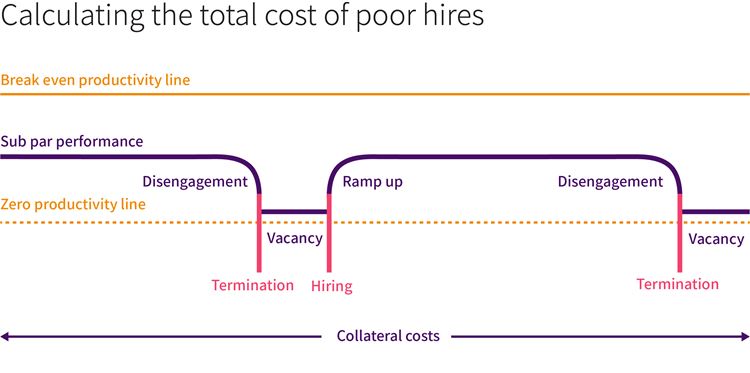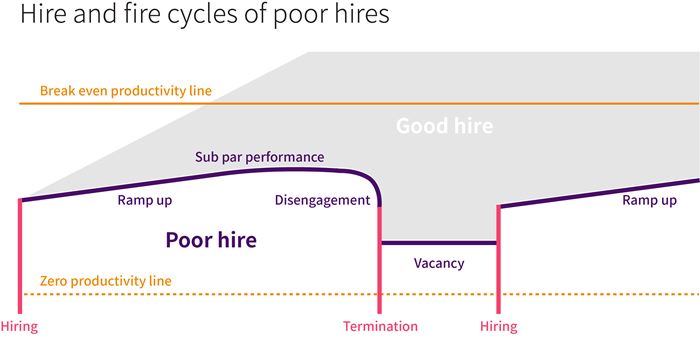Collateral Damage: Why the Cost of a Bad Hire Is Much More Expensive than You Think
Most bad hire calculators look at productivity only as it relates to the sub-par performance of the bad hire. But this isn’t telling the whole story. We need to look more broadly at collateral costs.

Have you underestimated the costs associated with a bad hire? Chances are you have, and you’re not alone.
A wide array of think tanks and consultants have tried to come up with bad hire “calculators” that, when applied to the average poor hiring decision, can generate significant dollar figures.
Typically, these calculators include things like salary, hours spent vetting and interviewing candidates, and investments in training.
The calculations on total cost can vary wildly. The U.S. Department of Labor, one of the most frequently cited sources, estimates the cost of a bad hire at 30 percent of annual salary. A survey of employers by a human capital company pegged the cost at about $14,000, while one search firm identified $240,000 in recruitment, compensation and retention expenses.
These calculations, however, typically exclude many collateral costs associated with bad hires because—you guessed it—it’s very hard to translate these costs into hard numbers.
The hard truth is that a bad hire can cause significant disruptions to organizational culture and workforce engagement. It can also irreparably harm your employer brand.
A broader look at collateral costs
It would be nice to think that most organizations usually avoid bad hires. The truth is that many organizations frequently hire the wrong person because they lack the methodology to find the right person, and that has a whole range of negative consequences.
When you consistently demonstrate a propensity to hire the wrong people, particularly for senior positions, you erode confidence—among employees, shareholders and customers—in your ability to manage the business.
Internally, lost confidence translates into lower employee engagement. In some instances, that loss of engagement may make your best people want to pick up and go somewhere else. A revolving door—where bad hires are coming in and top talent is on its way out—will tarnish your brand as an employer.
Unfortunately, the consequences do not stop at eroding engagement and employer brand. Bad hires also dramatically undermine your organization’s productivity.
Most bad hire calculators look at productivity only as it relates to the sub-par performance of the bad hire. When a new hire struggles, however, other employees are forced to assume heavier workloads. This is particularly problematic for teams, where strong performers will cover for poor performers to ensure that the entire unit does not suffer.
Even when you terminate a bad hire, you create a vacuum where everyone left behind has to perform additional duties to keep the team moving forward. That puts your best people under a lot of additional stress and strain.
All these consequences, taken together, create a vicious cycle of waste and disengagement.
Following a bad hire, productivity suffers from sub-par performance, which promotes disengagement among existing employees. In most cases, this type of performance results in a termination, which triggers more costs to fill the vacancy. If you haven’t yet addressed the systemic problems that contributed to the first bad hire, you’re in danger of repeating the process: costs of recruitment, sub-par performance and disengagement leading to another vacancy.
Remedies
What can an organization do to protect itself from bad hires? No organization is completely immune from this challenge, but there are three steps you can take to dramatically reduce the number and frequency of bad hires.
1. Get your new hire process out of the shadows. A detailed audit of recruiting, hiring, interviewing and assessment practices should help determine whether you are hiring the right people. This audit should tell you if your hiring criteria is overemphasizing things like technical skills and academic credentials, under-evaluating personality traits, overlooking workplace preferences, undervaluing motivations for work, poorly defining the values you want or failing to evaluate for critical thinking skills. You can use different tools to evaluate different elements. This may drive up initial costs, but that cost is more than offset by higher productivity and longer tenure achieved with a good hire.

2. Calibrate your interviewing. An objective audit should help you determine if hiring managers are performing candidate assessments in the same way or modifying the process and selecting candidates who look and sound like them. Hiring is still a human endeavor, and it’s important to take steps to curb bias.
3. Reverse engineer from exit interviews. Exit interviews with bad hires can reveal a number of important details. These could include people who were hired into jobs they were not qualified to perform or candidates who were strong on technical skills but weak on soft skills. The revelations from these exit interviews can be used to reverse engineer a better hiring process.
It’s important to remember that bad hires can, when they appear in greater numbers, reveal a whole range of bigger and more expensive problems with culture, engagement and hiring practices. Take the time to do a deep dive, and you may be able to escape the vicious cycle that starts with a single bad hire.
Wilt u slimme manieren ontdekken om de prestaties van uw organisatie te verbeteren?
We kunnen u helpen de kans te pakken.
Neem contact opMet meer dan 380 kantoren wereldwijd, zijn we altijd dichtbij.
Kantoor zoeken
